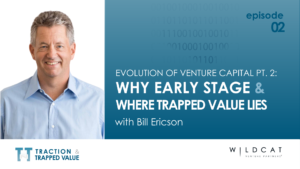Ep. 2- Evolution of Venture Capital Pt. 2
August 25, 2020
PUBLISHED BY Wildcat Venture Partners

In part 1 of our 2 part series on the Evolution of Venture Capital, Bill Ericson, Founding Partner at Wildcat, shared how industry dynamics have shifted to a point where the VC asset class now stretches the definition of “venture capital”.
With the current influx of non-traditional venture investors, coupled with the parallel growth in fund & round sizes, this may cause significant return compression over the next few years. So in part 2, we continue our discussion with Bill on what it takes to truly create long term value.
Why Early Stage is Better
While everyone else is going late stage, Bill and the Wildcat team focus on just the opposite. Bill shares that if you’re aiming for long-term wealth creation, early stage has consistently outperformed all other venture strategies for the past several decades and so far has avoided much of the overcapitalization that plagues the later-stage landscape.
One of Wildcat’s core principles is that in early-stage venture, small funds (several hundred million dollars or less) have structural advantages that enable them to outperform their larger peers.
The key advantage of early stage is being able to generate outsize multiples on winning investments thanks to ultra-low entry prices, which are only accessible before a company achieves traction. In a well-constructed small fund, one large winner can “return the fund” and provide a majority of the returns for the entire portfolio. In a larger fund, the returns are diluted across a larger asset base and therefore must come from many different winners. Given the limited (and declining) number of good startups founded each year, it can be difficult for large funds to find enough winners to deliver those venture-level returns.
Bill believes strongly that as an investor, if you have the ability to take a longer term view, you’re going to outperform later stage investments over a decade. And given the “power law” nature of early-stage returns, you can safely take a lot of risk at the company level, as long as you’re disciplined in how you deploy your dollars at the portfolio level.
Constraints as a Discipline
Bill’s view is that in order to generate the best returns, it’s all about discipline. First and foremost, you have to be a domain expert in the field in which you’re investing; that implies not trying to do everything under the sun.
Bill and the Wildcat team believe strongly in focused, thesis-based investing, in addition to keeping fund sizes below 250 million. Further, they leverage operational frameworks to support their portfolio companies, such as the Traction Gap Framework and Crossing the Chasm, which have been written by Wildcat partners Bruce Cleveland and Geoffrey Moore respectively.
Many startups fail during the critical go-to-market phase due to preventable mistakes. Therefore, good frameworks help portfolio companies avoid these mistakes, in addition to providing focus and guiding principles that drive operational efficiency.
Bill also believes that chasing the hot trends or sectors often harms a venture firm’s ability to drive outsized returns. By combining deep domain expertise, operational frameworks, and adherence to an early stage, small fund strategy, it’s possible to extract trapped value and build companies that last instead of filling a niche for a short term outcome.
Finding Trapped Value: It’s About Solving a Massive Problem and Best Practices
So what does it take to turn investment potential into real value? Bill says the first step is building deep knowledge about the industry (and ecosystem) you are investing in. Bill and the Wildcat team look for large-scale problems — with massive market value — that are being solved inefficiently or exploited by middlemen who take advantage of industry stakeholders. They call these “trapped value opportunities”, and identify companies that can unlock them by using technology to transform the way an industry operates.
When evaluating an opportunity, he conveys that you should strive to learn about every facet of the team, their business, and the problem they’re solving. You also need to understand how the target industry’s incentive structures and business processes are evolving, and whether a technology is truly able to solve the problem at hand— or not. Because in early stage, it’s about the market, people and ideas. You have to have the full view of who wins, who loses, and who you can disrupt.
Industries where Wildcat currently sees massive trapped value opportunities include healthcare, insurance, and education.
Throughout the investment process, the Wildcat team also applies best practices derived from their depth of experience going through full investment cycles — particularly past economic downturns. This historical awareness can provide valuable insights when it comes to managing the spectrum of risks and identifying untapped opportunities.
While every firm focuses on different categories and different stages, applying discipline over the long term is what will generate outsized returns in the end.
Traction and Trapped Value is produced by Flywheel Associates
KEYWORDS